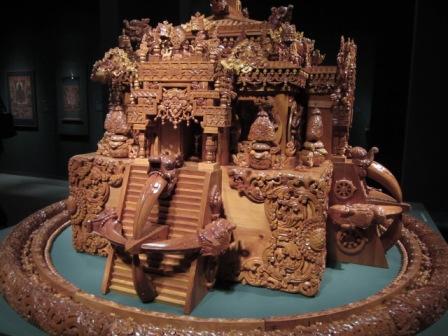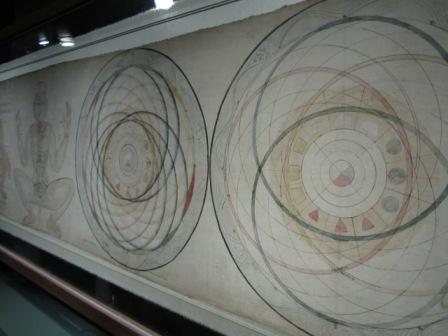
The three-dimensional mandala of Guhasamaja from Gyuto Monastery in India- a large wooden palace, carved so intricately it would take you hours to notice all the details. Photo credit: Lisa Stock
By Lisa Stock
Contributing Writer
In a world often defined by small cubicles, cramped airplanes, thick traffic and crowded super-stores, personal space is greatly sought but not often achieved. Recently, I’ve limited mine to my smart phone, the steering wheel and whatever computer or TV screen is in front of me. My personal space has effectively become a cluttered mess of sometimes organized mayhem. Or so I thought, until I went to MANDALA: SACRED CIRCLE IN TIBETAN BUDDHISM at the Michael C. Carlos Museum at Emory University through April 15. The Buddhists have a unique and beautiful perspective on sacred space and honor that through the tradition of mandalas.
Mandala is the Sanskirt word for “circle” and can also mean “house” or “palace” in the Buddhist tradition. The mandala serves as an aid to meditation on the path to enlightenment, and helps to view the world in more harmonious ways. The term can be applied to everything from the sphere of the universe, to a circular painting, to the space you create around yourself. As presented in the exhibit, the art of mandalas is not limited to circular paintings but also manifests in tapestries, reliquaries and sculpture. The most impressive piece is the three-dimensional mandala of Guhasamaja from Gyuto Monastery inIndia- a large wooden palace, carved so intricately it would take you hours to notice all the details. But that’s the beauty of mandalas – you could easily stand there all day and look at them. They are said to bring peace and harmony to the creator and viewer.
The message of the exhibit is the concept of sacred space. Each of us creates our own personal mandala of sacred space. It’s what we put out to our families, our coworkers and friends, and what we take inward as well. My mandala may seem narrow at times, but it can be a beautiful one. If I’m collecting photos on Pinterest of faraway places I’d like to visit and those inspire me to take a walk in the park at lunch to see the trees budding early, then that computer has become part of a tranquil mandala. Our sacred space is, truly, what we make it. This exhibit is definitely one you carry out into the world with you. To that point, from Feb. 1-11, monks from the Drepung-Loseling Monastery will construct a sand mandala on site. On April 15, the sand will be swept into a container and poured into the nearby stream so the blessing of the mandala can spread throughout the city.
In conjunction with MANDALA: SACRED CIRCLE IN TIBETAN BUDDHISM, the Carlos Museum are also offering an extensive list of related programs such as “Embodying Nirvana: Meditations on Buddhist Mandalas,” a lecture by John Dunne, Associate Professor of Religion at Emory University (Feb. 9, 7:30 p.m.); Artful Stories (for children on Feb. 18); AntiquiTEA – tea and a lecture on the importance of a rice mandala (March 6) and more. For more information and a complete schedule of events, click here.

